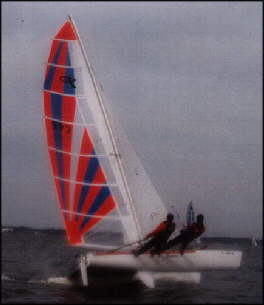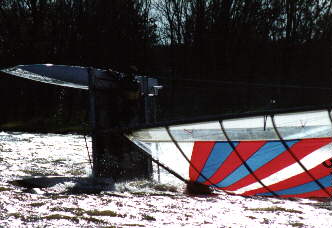

|
The Heavy Air Jibe Clean Turns in Big Air By Mike Hill |
| Heavy air is anything between 20-30 mph. Anything more than that is nuclear air which I try to avoid when possible. I sail a Hobie 20 so it takes a little less air than on some boats to become a very critical situation. One of the keys to heavy air sailing is getting through the turns cleanly without loosing control. When sailing in heavy air it is important to keep the crew weight in the back of the boat to keep the rudders in the water so that you can steer through the puffs. If racing in heavy air you should jibe in the puffs if possible. By jibing in the puffs you will power up quicker getting the boat up to speed sooner. |

|
|
The key to a clean and easy jibe in big air is to keep the main traveled to just
inside the hull. Also sheet the main to where it would be for a normal sailing day
before starting your jibe. Turn the boat quickly without putting on the brakes with
the rudders. Keep one hand on the tiller and the other hand on the line between
the mainsheet blocks. As you turn pull hard on the mainsheet lines to throw the
boom to the other side of the boat as soon as possible. When the boom flies to
the other side of the boat you are forced to release the tiller for a second, unless
you want to loose a hand. Immediately grab the tiller with the hand that was on
the mainsheet blocks. The other hand that was on the tiller should grab the
mainsheet and uncleat it. Your weight should be on the proper side and in the
rear of the boat and ready to power up again. If the main pops over and the hull
immediately starts to rise, release the main and steer back deep downwind.
Otherwise if the main pops over and you just accelerate like crazy, you have
completed a clean heavy air jibe.
The one thing that beginners do that causes them to be afraid to jibe in heavy air is leaving the mainsheet and traveler to loose prior to the jibe. Leaving the mainsheet and traveler loose going into the jibe forces the boat to move further through the wind before the boom will come across. When the boom does come across the boat is too high and immediately wants to flip. Keeping the main sheeted some and the traveler just inside the hull going into the jibe allows the boom to come over prior to heading up too much and thus being able to control the boat better. |
| The picture is of an unintentional jibe on a nuclear day (around 35mph). Thatís the crew on the boat wondering where I went. I never even got out of the harbor that day. I was going a little too deep downwind with my main loose and WHAM what a jibe. Iím just glad there were people ready with the camera to catch my blunder. |

|
|
Mike Hill mhill@inlink.com Back to Features |